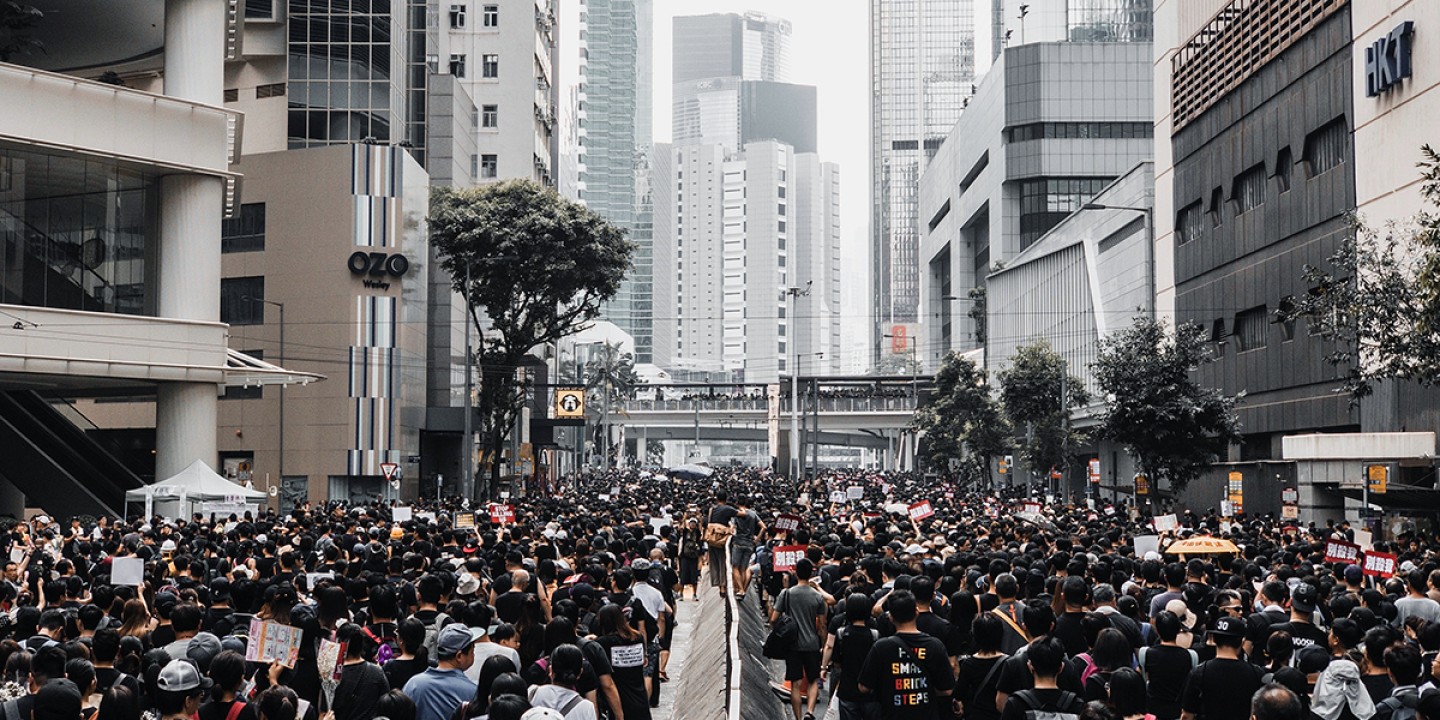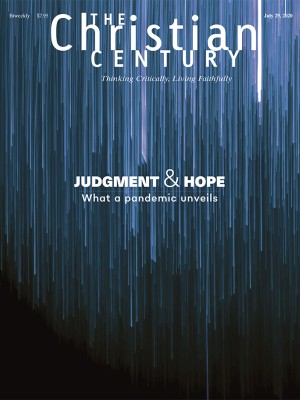What it means to be a body in Hong Kong
The protests confront us with a difficult question.

I’ll never forget the first time I saw someone shoot another human being. One of Hong Kong’s major democracy marches had just ended, and thousands of demonstrators were beating a tense but orderly retreat down one of the city’s main thoroughfares. The view from my restaurant window resembled a classic side-scrolling video game: waves of black-clad protesters scurried from left to right, pursued by a volatile sea of riot police. One officer slowed down, raised his orange-stocked (officially: “less-lethal”) shotgun, and fired a volley of rubber bullets into the crowd. Moments later a second muzzle exploded, filling the street with acrid plumes of tear gas.
This was a far cry from the Hong Kong of my youth. Growing up I had worried more about homework, grades, and childhood crushes than my own physical safety. Yet to walk around Hong Kong these days is to be constantly aware of one’s body—of its utter helplessness against tear gas, rubber bullets, or worse.
Read our latest issue or browse back issues.
These protests raise the question of what it means to be a body. They confront us with the inescapable truth of our physical bodies: their susceptibility to pain and death. They awaken us to the existence of social bodies that safeguard our vision of the common good. And they reveal the need—and opportunity—for the church to reclaim its identity as an ecclesial body that dares to wade in the waters of political discernment.
For over a year, Hong Kong has been inundated with footage of people being clubbed, dragged, choked, gassed, pepper-sprayed, head-stomped, bitten, blinded, stabbed, shot (with real bullets), and even tossed from residential buildings. Ours is a city where protesters’ bodies are found floating in the sea, where suspicious suicides have become a hashtag, where sparrows lie dead on the sidewalks, asphyxiated by tear gas.
Even more chilling is what we don’t see: the widespread allegations of torture and sexual assault committed by police behind closed doors; the ordinary citizens supportive of the protest who have been disappeared; the extrajudicial rendition of consulate workers like Simon Cheng, whose testimony confirms that other Hong Kongers are being whisked across the border to suffer a similar fate. This is a campaign designed to end the pro-democracy movement by blunt force.
In short, to be from Hong Kong these days is to grapple with death. While this is deeply jarring, it also reorients us toward the central fact of our existence: our mortality. “Death is the only unavoidable part of life,” writes the Orthodox theologian John Behr. “It is the only thing I can be sure of, and, thus, the only thing which I must contemplate.” For the Christian, this truth has startling implications: because Christ has trampled death by death, our suffering and mortality can now be transfigured into a means of participation in the life and work of God. The apostle Paul affirms this when he describes being flogged, beaten, shipwrecked, and stoned and yet rejoices as “we who are alive are always being given over to death for Jesus’ sake, so that his life may also be revealed in our mortal body” (2 Cor. 4:11). Borrowing from the words of Maximus the Confessor, Behr notes that “we need no longer be passive victims of the mortality into which we have been thrown, for now we can actively ‘use death’ as the beginning of a new mode of life, a birth into existence as a human being.”
This fundamental link between our mortality and humanity is a powerful source of motivation for those on the streets in Hong Kong. As one mild-mannered protester told me, “I’ve been beaten up by the police, but there are 12- and 13-year-olds out there. If I don’t go, how am I even a human being?” The bruises on his arms spoke for themselves.
Joseph Ha, auxiliary bishop of the city’s Catholic diocese, also reflected on this link in a homily after meeting with protesters camped outside the legislature. “When I heard these young people sharing their stories, I saw and felt how humanity is beautiful and good. Despite so many injustices, humanity continues to shine.” By embracing their mortality, he mused, they had stumbled into a more human existence, becoming icons of Christ’s sacrificial love. “I saw the image of the Lord written in the depths of their soul: they are not here only for themselves.”
Those sympathetic to the movement would agree. As the latest episode in a long history of dissent, today’s protests aim to protect Hong Kong’s core values—freedom, human rights, democracy, rule of law, and clean governance—from further erosion. In Torture and Eucharist, William Cavanaugh shows how such egalitarian values are preserved through a network of social bodies comprised of NGOs, civic associations, and various political, economic, and academic institutions. Like individual bodies, these entities “involve the coordination of many different members into certain coherent shared activities or performances.” Together, they serve as an intermediary buffer between individual citizens and the ruling regime.
It is no surprise, then, that these social bodies are now under attack. When the Hong Kong government issued a new law prohibiting the use of face masks at protests, the city’s high court intervened to defend people’s constitutional right to privacy. Less than a day later, China’s top legislative body contested the court’s authority to do so. Meanwhile, press freedom has deteriorated in the wake of deadly assaults, high-profile deportations, state-sponsored advertiser boycotts, and a suffocating climate of self-censorship. Once ranked 18th in the World Press Freedom Index, Hong Kong now ranks a lowly 80th.
The attacks don’t stop there. Universities have been held under siege, teachers’ unions have been silenced, leaders of pro-democracy groups have been bludgeoned and arrested, corporate executives have been ousted for refusing Beijing’s demands, and an aspiring cohort of young pro-democracy legislators has been disqualified on specious grounds. Even as I write this, China is imposing new security legislation that will bypass Hong Kong’s constitutional framework and crush what remains of the city’s already tattered freedoms. Cavanaugh confirms that this “assault on social bodies” is “consonant with the military regime’s strategy to fragment the society, to disarticulate intermediate social bodies between the individual and the state—parties, unions, professional organizations—which would challenge the regime’s desire to have all depend only on it.”
Faced with such tactics, Hong Kongers have redoubled their efforts to consolidate and defend their existing social bodies, with impressive results. Within months, protests have been organized by coalitions of students, teachers, mothers, senior citizens, churches, pastors, lawyers, legislators, journalists, academics, doctors, nurses, accountants, aviation staff, social workers, sexual assault survivors, civil service administrators, relatives of police officers, even pet owners. It is fitting, then, that one of the movement’s chief aims is to establish yet another social body: an independent commission to investigate the rise of police brutality. Needless to say, the government has refused.
Christians, of course, are familiar with the notion of social bodies because they inherently belong to one—the church. Historically, this community has been understood as the visible, concrete body within which we experience and live out our faith. Contrary to our modern instincts, early believers viewed the church as the fundamental unit of Christian existence, according it more weight than their own individual convictions. The church was not merely an agglomeration of individuals with similar doctrinal proclivities; it was a visible body of communion that joined people to each other and to Christ in the sacrament of the Eucharist. “We who are many are one body,” declares St. Paul, “for we all partake of the one bread.” From its inception, the church has been understood as a body.
This ecclesiology has concrete implications for churches facing repressive regimes. Trapped in a tinderbox of opposing views, church leaders are often tempted to stress the church’s invisible, spiritual unity as a way to defuse tensions within their communities. “We may each have different political opinions,” says the well-meaning preacher, “but we are all united in Christ.” Internal division—rather than the structural violence of the state—becomes the chief enemy.
Unfortunately, this emphasis on our interior, invisible unity (often framed in terms of the “mystical body of Christ”) can inadvertently lead the church to retreat from its responsibility to discern the spirits in the political arena. By championing unity and reconciliation above all else, the church apes the logic of relativism and refuses to name good or evil in order to avoid offense. In so doing, it abandons the task of political discernment to the individual Christian, forgetting its own nature as an ecclesial (let alone prophetic) body.
This amnesia has disastrous consequences for broader society: the church effectively disappears itself from the intermediary canopy of social bodies, leaving a gaping hole for the regime to exploit. “That the body of Christ be made visible in history is for the sake, not of itself, but of all people,” writes Cavanaugh. To shrink from this responsibility is to leave the gate open to the wolves.
What does it mean, then, to be a body—physical, social, and ecclesial? The Hong Kong–based church group Protect the Children may offer some clues. Known for their iconic yellow vests, these homemakers, truckers, accountants, and teachers (not to mention several octogenarians) have been a fixture at the protests since the beginning. “At the scene we split into teams,” explains pastor Roy Chan, one of their founders. “We form a human chain and try to stop the police from advancing. That’s the self-sacrifice spirit: beat us, don’t beat the kids.”
In November, more than 40 Protect the Children members gathered at Hong Kong Polytechnic University, where hundreds of students were being held under siege. The police had signaled their willingness to use real bullets, and a group of officers had urged those inside to stay put so they could repeat the events of Tiananmen Square. One officer even announced that he would “go to Poly U to slaughter cockroaches.” Amid this tension, Protect the Children finalized its plans.
“We will stay and keep watch over this place,” proposed one of the group’s leaders. “If anyone wants to leave, we’ll protect and escort them out, OK?”
The members agreed.
Another leader spoke, his voice trembling. “As a pastor, may I lead us in prayer? I would like to bless you. Yahweh, you are our General, our Help, our Shelter . . .”
In this exchange, the members of Protect the Children teach us what it means to be a body. By offering their own physical bodies to shield the students, their mortality is transfigured into the image of the crucified Christ—the true human being. By uniting together as a social body, they provide an intermediary buffer and are able to escort those in the state’s crosshairs to safety. And by prayerfully acknowledging their role as an ecclesial body, they are equipped to exercise political discernment and respond to the regime as the church, not merely as atomized believers.
“As a Christian, this is what I can do for society and for God,” says Chan, his voice calm and resolute. “The Bible says ‘there is no fear in love.’ We come out with the power of love. It may be just an unrealistic dream, but we are willing to try.”
A version of this article appears in the print edition under the title “Many protesters, one body.”






